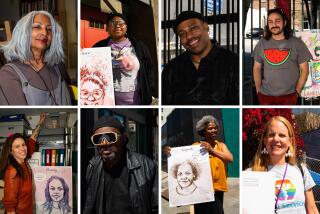Into the Halls of Heritage
The Skirball Cultural Center has held an annual Hanukkah festival since it opened its doors in the Sepulveda Pass in April 1996. But this weekend, the center--which celebrates “the intersection of Jewish heritage and American democratic values”--is marking not only the beginning of the Jewish holiday, but also the reopening of its redesigned and expanded exhibition galleries.
Closed since September, the center’s galleries reopen to the public Sunday after a $2-million renovation and expansion funded by the California Arts Council. The improved galleries feature 300 new objects, several new classrooms, and new interactive programs designed for the many children who visit the center.
The exhibition space--renovated to accommodate the rapidly increasing number of visitors to the center--has been reconfigured to improve traffic flow. New lighting and bigger type on the information placards makes for easier reading.
Highlights of the expanded core exhibition include an early copy of the Declaration of Independence; cannonballs that flew during the Revolutionary War; George Washington’s presidential china; an early copy of the Emancipation Proclamation as well as Abraham Lincoln’s quill pen and stovepipe hat; and storefronts showcasing the range of occupations of the country’s Jewish workers.
Also prominent in the new exhibition are original typescripts of the Nuremberg laws, which helped lay the groundwork for the Nazi Holocaust and are signed by Adolf Hitler. The documents, held in a vault at the Huntington Library in San Marino since 1945, are on indefinite loan to the Skirball.
Martin E. Dannenberg, one of three American soldiers who found the original documents in Eichstaett, Germany, will be part of the new lecture series on Dec. 12.
The gallery redo is the latest success story for the Skirball, which since its opening has led a seemingly charmed existence. At the time of its opening 3 1/2 years ago, officials of the Skirball Cultural Center predicted that the facility would draw about 65,000 visitors in the first year. Instead, 300,000 came.
Where other nonprofit cultural institutions struggle to survive, the $65-million Skirball Cultural Center--launched with a donation of close to $30 million from the Skirball Foundation--operates free of debt; has doubled its annual operating budget from $4 million to $8 million; has raised more than $150 million for programs, operations and expansion; has seen its endowment grow from zero to $30 million; and has hosted 1.1 million visitors--200,000 of them children.
Uri D. Herscher, 58, president and chief executive officer of the center, said that Skirball’s successes have been satisfying beyond attendance and budget figures. In keeping with his pledge to create a center not only for the Jewish community but also the greater community of Los Angeles, Herscher notes with pride that 50% of Skirball visitors are not of the Jewish faith, and some $40 million of the money raised to date has come from non-Jewish sources.
The Skirball, just up the road from the Getty Center, seeks to differentiate itself from the nearby Simon Wiesenthal Museum of Tolerance, which focuses on the Holocaust and other instances of genocide, by concentrating on the hopeful aspects of the American experience. Its galleries take visitors on a journey through the American immigrant experience, with a focus on the story of America’s Jews.
Uppermost in Herscher’s mind is telling that story to children. On weekdays, the center is closed to the public from 9 a.m. to noon except to children, most of them from the local public school system, arriving in buses paid for by Skirball fund-raising.
Herscher said that the nature of Los Angeles’ increasingly diverse population of schoolchildren, many of whom are studying and grappling with the issues of their own immigrant history in the public schools, served as the main impetus for the gallery expansion.
“We learned that the content of our [museum] story line and the galleries fit so well with the curricular materials of the school system K through 12,” he said. “The reason for the redesign and the reopening is that we wanted to be even more emphatic in our connection with the teaching of the students in this community.
“The schoolkids are primarily not only not Jewish, but also not white. Many of them are underprivileged; we have hired tutors for kids, and made sure they have a good dinner before they get back on the bus. Everything is sponsored and financed by us.”
In 2002, the Skirball will further its commitment to children by opening the Winnick Family Heritage Hall, currently under construction. The new wing will house two galleries dedicated to the heritage of children of all races and religions in Los Angeles (the new Ahmanson Hall, which will contain a performing arts space, opens at the Skirball next year).
“I can’t ever feel down, coming to work and seeing 10 yellow school buses in our parking lot in the morning; it’s the joy of my day,” Herscher continued. “So much of what we hoped would happen has happened.
“I would say that the most precious affirmation has been that our mission statement is alive and well and stronger than ever, now that it’s been tested.”
*
* Skirball Cultural Center, 2701 N. Sepulveda Blvd. Tuesdays-Saturdays, noon-5 p.m.; Sundays, 11 a.m.-5 p.m. Closed Mondays. $8 general admission; $6 seniors and students; children under 12 free. (310) 440-4500.
More to Read
The biggest entertainment stories
Get our big stories about Hollywood, film, television, music, arts, culture and more right in your inbox as soon as they publish.
You may occasionally receive promotional content from the Los Angeles Times.










